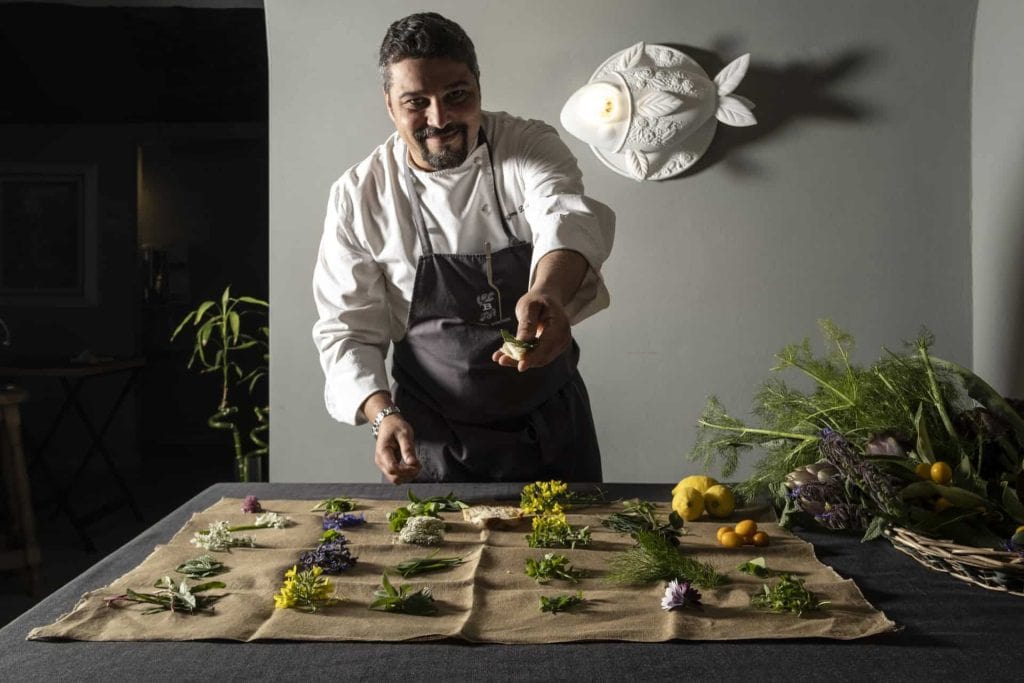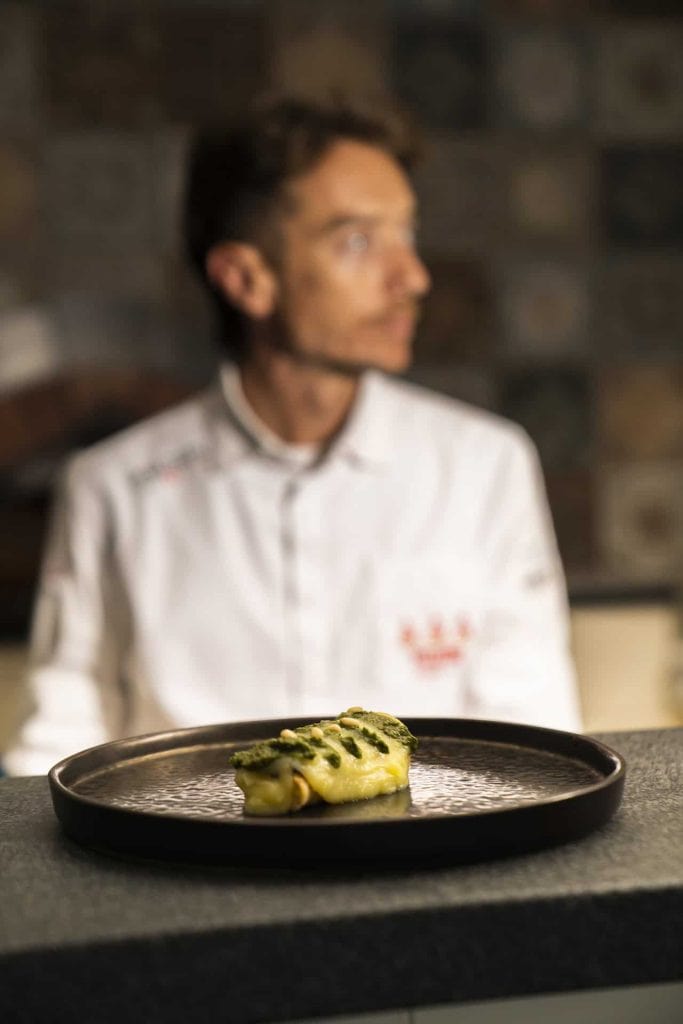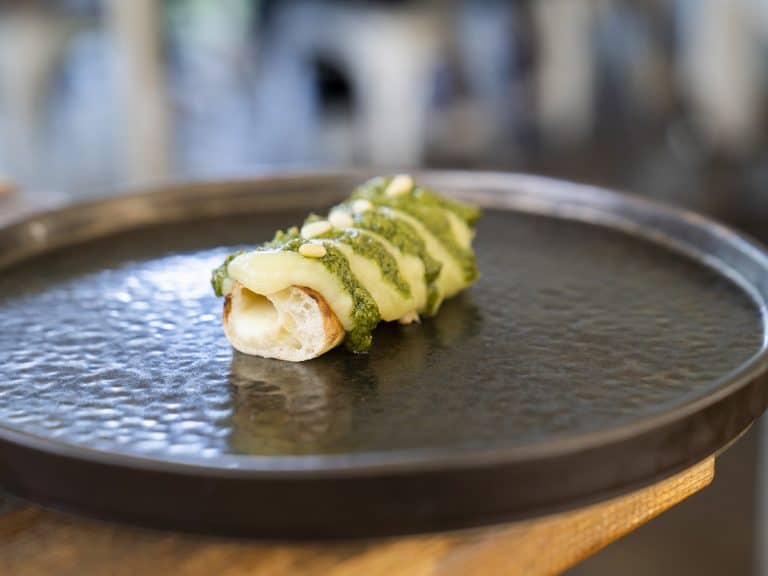by Giovanni Caldara
With our eyes blindfolded to focus on what happens in our mouths at the first taste, the palate fills with the enveloping notes of the topping. Supporting it all is that strip of dough that gives irresistible structure to the dish. However, we’re not talking about a first course, nor strictly about a pizza, but rather its humble crust, which here – at Officine del Cibo in Sarzana (SP), awarded three slices according to the Pizzerie d’Italia guide by Gambero Rosso – is served alone, in all its novel and innovative dignity, demanding all the attention it deserves.

The idea of serving the crust
Its creator, chef and owner Giacomo Devoto, explains: “When I first introduced authentic Neapolitan pizza to the areas of La Spezia and Massa Carrara, I tried to educate each table on how to enjoy this extraordinary pizza. I even recommended cutting it into four slices, folding each one, and eating it all together, using the crust as part of the chewing process, since Neapolitan pizza is very soft in its centre, lacking the firmness you’ll find in the crust. It broke my heart to see pizzas emptied in the middle with the crust left abandoned on the plate. I began to wonder why people couldn’t seem to appreciate the crust. So, somewhat provocatively, I started offering ‘The best part of the pizza,’ as I’ve called the crust on the menu ever since.”

Experimenting with fillings
This was a small Copernican revolution, achieved through trial and error, which led Officine del Cibo to serve the crust as it’s now presented in the “We tell you about our pizza” menu (in five courses, at a competitive price of 25 euros per person) and in variations – like the four-cheese crust – included in another menu, “Pizza_lab Contemporanea” (at 30 euros per head). Gianmarco Ferrandi, master pizzaiolo and essential right-hand man to Giacomo Devoto at Officine, explains: “The ‘cultural’ shift we had to nail down was the type of filling we identified, only after countless trials. Among the first crusts served was one with squid ink, mackerel roe, lemon, and candied lemon – visually beautiful but perhaps too strong in taste. Another very good one combined potato cream, cuttlefish, and katsuobushi. The definitive one, though, is the current one: it features potatoes, pesto, and pine nuts – a magnificent combination, perfect because it’s 100% Ligurian and serves as the ideal ‘Trojan horse’ to get our fellow citizens to eat this blessed crust.”
Authentic Neapolitan crust
The dough, made directly, adheres to the standards of authentic Neapolitan pizza, using only four ingredients: water, flour, yeast, and salt. There’s no oil – “which we naturally don’t put in the containers either,” Gianmarco clarifies – nor any other type of fat. From this authentic classic dough, strips about twenty centimetres long and two centimetres wide are made, filled with provola, then closed like crusts and baked separately for a minute and a half in the wood-fired oven. At what point in the menu is the crust served? “Always halfway through the tasting menu, because it must be the centrepiece of the experience,” Gianmarco continues. “At the end of the meal, we save the most indulgent ideas, for when the customer is almost full, like fried pizza. The crust for us must have the right importance and be fully appreciated: it shouldn’t be eaten too quickly at the beginning when people are too hungry. It comes out as the third course of five.”

Officine del Cibo di Sarzana's team
The pairing
To further emphasize its importance, it’s worth noting that the crust – and all pizzas served at Officine del Cibo – are accompanied by a steak knife with a substantial wooden handle. And let’s not forget the carefully crafted pairing, here entrusted to a sensitive bartender who also professionally and dedicatedly oversees the dining room, Simone Bellè: “The flavours of the Ligurian crust – he explains to us – appear delicate at first but then become more pronounced, with the smoked provola, pesto, and pine nuts, all ingredients with strong characteristics. Therefore, I try to pair it with a cocktail that offers sweet notes to complement the provola and potato cream while also providing a hint of acidity to ensure a clean palate. The ideal pairing is my Gin Basil Smash made with basil, local berries, orgeat, and raspberry-infused gin.”
Lastly, a curiosity: why have Officine del Cibo focused their offerings on authentic Neapolitan pizza, here in Liguria, far from its homeland? “Partly by chance and partly due to an emotional connection,” chef Devoto concludes. “My great-grandmother, before moving to La Spezia, lived in the Spanish Quarters, not far from Pignasecca, where I did an internship with the great Attilio. When I sold the Refuge in Valle d’Aosta where I worked, I found myself back in Sarzana, feeling that something was still missing in my professional baking skills. So, after tasting authentic Neapolitan pizza several times, I got excited and enrolled in courses. After which the Association trusted me, encouraging me to open my pizzeria. It was 2015, and Officine del Cibo would open its doors in 2016.”


 Meloni: "Tariffs? If necessary, there will be consequences. Heavy impact on agri-food sector"
Meloni: "Tariffs? If necessary, there will be consequences. Heavy impact on agri-food sector" The Government honours the greats of Italian cuisine, from Bottura to Pepe. Massari: "Thank you, Meloni, the only one who listened to us"
The Government honours the greats of Italian cuisine, from Bottura to Pepe. Massari: "Thank you, Meloni, the only one who listened to us" "We must promote a cuisine that is not just for the few." Interview with Massimo Bottura
"We must promote a cuisine that is not just for the few." Interview with Massimo Bottura Wine was a drink of the people as early as the Early Bronze Age. A study disproves the ancient elitism of Bacchus’ nectar
Wine was a drink of the people as early as the Early Bronze Age. A study disproves the ancient elitism of Bacchus’ nectar "From 2nd April, US tariffs between 10% and 25% on wine as well." The announcement from the Wine Trade Alliance
"From 2nd April, US tariffs between 10% and 25% on wine as well." The announcement from the Wine Trade Alliance






